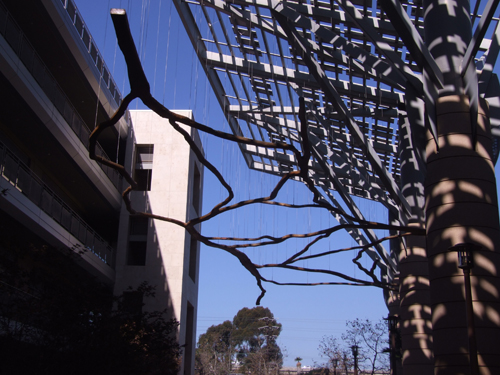
-Eighth in a series-
Exit 3: Taylor Street, San Diego — Wadie P. Deddeh State Office Building

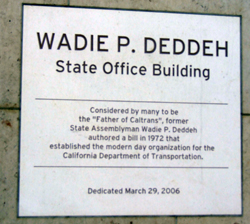 SAN DIEGO — No, Wadie P. Deddeh isn’t Jewish. He’s an Iraqi Christian, whose success in San Diego County rising from a professor at Southwestern Community College to a state Assemblyman and eventually to a state Senator was an inspiration to numerous refugees from Iraq who felt, rightly, that San Diego County was a place where people could rise on the basis of merit.
SAN DIEGO — No, Wadie P. Deddeh isn’t Jewish. He’s an Iraqi Christian, whose success in San Diego County rising from a professor at Southwestern Community College to a state Assemblyman and eventually to a state Senator was an inspiration to numerous refugees from Iraq who felt, rightly, that San Diego County was a place where people could rise on the basis of merit.
Today, San Diego County ranks only behind Detroit as a U.S. population center for Iraqi Christians, also known as Chaldeans. During his political career, Deddeh counted many friends in the Jewish community, including his long time chief of staff Love Sachs, and he also had Jewish adversaries. In 1992, Deddeh fought and lost a bruising Democratic primary for a congressional seat against Bob Filner, who went on to serve 10 terms before being elected as San Diegos 35th mayor. The year following his mayoral election, Filner resigned amid charges of sexual harassment. The Deddeh family meanwhile continued to cover its name in honor, with the former legislator’s son, Peter Deddeh, serving on the San Diego County Superior Court bench.
A plaque near the entrance of this three-building complex dedicated in March 2006 at 4050 Taylor Street explains why it is named for Deddeh: “Considered by many to be the ‘Father of CalTrans’, former state Assemblyman Wadie P. Deddeh authored a bill in 1972 that established the modern day organization for the California Department of Transportation.”
Stepping inside the courtyard of the CalTrans complex one may see various artistic renderings of San Diego County’s freeway system. Hanging overhead, for example, is what the uninitiated might think is a representation of a tree grown wild, or perhaps a willy-nilly explosion of vines, but in fact, if one imagines oneself standing in Tijuana, Mexico, the trunk is the road leading from the south to the branching of Interstate 805 from the Interstate 5. The sculpture shows the two freeways joining again in the Sorrento Valley area, and depicts other freeways with which the two intersect. On a gate between the courtyard and Taylor Street is a sculptor’s look at the interchange of Interstate 8 and Interstate 805.
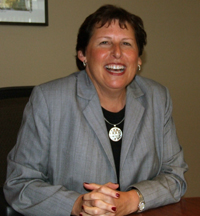
Approximately 1,200 state employees plan, build and maintain the freeway system in San Diego and neighboring Imperial County–the border portion of California through which Interstate 8 passes. Leading them is a Jewish woman, District 11 Director Laurie Berman. She is a Michigan State University engineering graduate whose first job out of college was in CalTrans’ bridge-building department. She stayed with the state agency, moving from job to job, until 2009 when she was named district director.
Among Berman’s lieutenants is Mark Phelan, a senior transportation supervisor, who, in an interview for this book, pointed out some features of the freeway system that motorists might give only passing notice to, but which are important in CalTrans’ quest to provide the means for motorists not only to get where they want to go, but to do so safely.
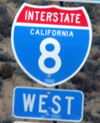 Freeway Numbering: Odd number freeways, be they Interstate Highways or California State Highways, generally go north and south. Even-numbered freeways go east and west. The national Interstate freeway system was laid out as a grid with one- and two-digit numbered highways ending in “5” running between the northern and southern borders of the continental United States (excluding Hawaii and Alaska). Two-digit Interstate freeways ending in “0” run across the continent between the east and west coasts (again excluding Hawaii and Alaska). Interstate Freeways with other numbers (such as I-8, and I-805) parallel only a fraction of those routes and are considered secondary portions of the Interstate System. Whereas Interstate 10, starting in the Los Angeles area, stretches all the way to the East Coast; Interstate 8 goes only as far east as Casa Grande, Arizona.
Freeway Numbering: Odd number freeways, be they Interstate Highways or California State Highways, generally go north and south. Even-numbered freeways go east and west. The national Interstate freeway system was laid out as a grid with one- and two-digit numbered highways ending in “5” running between the northern and southern borders of the continental United States (excluding Hawaii and Alaska). Two-digit Interstate freeways ending in “0” run across the continent between the east and west coasts (again excluding Hawaii and Alaska). Interstate Freeways with other numbers (such as I-8, and I-805) parallel only a fraction of those routes and are considered secondary portions of the Interstate System. Whereas Interstate 10, starting in the Los Angeles area, stretches all the way to the East Coast; Interstate 8 goes only as far east as Casa Grande, Arizona.
Types of Freeway Signs: Six colors predominate in freeway signage, according to Phelan. These are:
—Green signs with white letters provide guidance to destinations. They tell the distance to upcoming exits and towns, and identify the exits. The exits are numbered according to their distance in miles from the beginning of the freeway. In the case of Interstate 8, the measurement is from the freeway’s onset at Robb Field in Ocean Beach. Green and white signs also identify honorific portions of the freeway, so designated by the state Legislature, such as, on Interstate 8, the “Kumeyaay Highway,” named for the indigenous people of San Diego County. Currently, the white letters on the overhead signs are made with reflective materials which are activated by your car’s headlights. There are plans to convert an estimated 37,000 such signs in District 11 so that both the green and the white tiles will be lit by a car’s headlights. That will enable the district to reduce electricity use and also to remove the catwalks in front of the signs which attract spray-painting vandals.
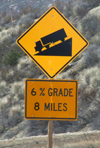 —Yellow signs with black letters are intended to warn motorists about road conditions ahead, such as onramps where traffic may be merging; or a bridge where the number of lanes are reduced; or a tricky curve. They warn motorists to exercise caution.
—Yellow signs with black letters are intended to warn motorists about road conditions ahead, such as onramps where traffic may be merging; or a bridge where the number of lanes are reduced; or a tricky curve. They warn motorists to exercise caution.
—Orange Signs are similar to yellow signs, but they are temporary, and are used in construction zones.
 —Brown signs are used for state-designated points of interest such as historical landmarks or national and state parks.
—Brown signs are used for state-designated points of interest such as historical landmarks or national and state parks.
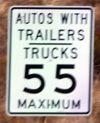 —Black and White signs are used for traffic laws, especially to announce speed limits, anti-litter regulations, carpool lane restrictions, and other rules of the road. Phelan says the federal goverment allows states to decide on speed limits up to 80 miles per hour on Interstates. In California, where 65 is the standard freeway speed, 70 sometimes is allowed in rural areas. According to Phelan, speed limits are determined according to “road geometry, the curves in the hill, and also they are tied into population. The higher the population, the lower speeds. It gets up to 70 outside the metropolitan area.”
—Black and White signs are used for traffic laws, especially to announce speed limits, anti-litter regulations, carpool lane restrictions, and other rules of the road. Phelan says the federal goverment allows states to decide on speed limits up to 80 miles per hour on Interstates. In California, where 65 is the standard freeway speed, 70 sometimes is allowed in rural areas. According to Phelan, speed limits are determined according to “road geometry, the curves in the hill, and also they are tied into population. The higher the population, the lower speeds. It gets up to 70 outside the metropolitan area.”
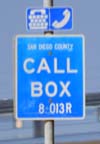 —Blue signs assist motorists, telling, for example what offramp to take for a hospital, gas, food, or lodging, and where emergency phones are located alongside the freeway.
—Blue signs assist motorists, telling, for example what offramp to take for a hospital, gas, food, or lodging, and where emergency phones are located alongside the freeway.
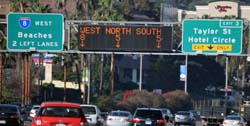 Additionally, there are electronic signs suspended over freeways on which are flashed safety messages and occasionally “amber alerts,” in which the description and license plate of a car is given of a motorist suspected of abducting a child. The amber alert was named for 9-year-old Amber Hagerman of Arlington, Texas, who was abducted and murdered in 1996. Her given name was later formed into an acronym for America’s Mission: Broadcast Emergency Responses.
Additionally, there are electronic signs suspended over freeways on which are flashed safety messages and occasionally “amber alerts,” in which the description and license plate of a car is given of a motorist suspected of abducting a child. The amber alert was named for 9-year-old Amber Hagerman of Arlington, Texas, who was abducted and murdered in 1996. Her given name was later formed into an acronym for America’s Mission: Broadcast Emergency Responses.
A relatively new type of signage on the Interstate 8 are large road decals, helping motorists decide what lane they need to line themselves up on for interchanges. Director Berman said the I-8 and I-5 decals on the surface of Interstate 8 in the Hotel Circle area (Exit 4) were installed because Hotel Circle caters particularly to tourists, who may be unfamiliar with San Diego’s road system. When going west, which lane do they want to continue to the beach? What about to go to Los Angeles? Or to head to Mexico?
Digital and broadcast messaging: At various freeway locales, AM radios may be tuned to 511 for the latest traffic information. CalTrans regularly posts traffic conditions on Twitter, with such messages often being the basis for news stations’ traffic reports. This information also can be accessed by various in-car navigation systems.
Freeway Surfaces: Concrete is the standard surface for Interstate freeways, but sometimes a less rigid, more flexible surface like asphalt is used over land where there is subsidence. Unless it is broken by too heavy truck loads, concrete will last longer than asphalt, but it is far more expensive to replace. Whereas it once was standard procedure to utilize concrete for the freeways and asphalt for the shoulders, federal guidelines for future construction require, under most circumstances, concrete to also be used for the shoulders.
In Southern California, with its arid and temperate climate, bridges generally are constructed of concrete, rather than steel which is used throughout much of the country. However, steel was utilized for the San Diego-Coronado Bay Bridge, requiring constant painting and maintenance to guard against moisture-driven rusting.
Onramps and offramps: Whether ramps are one lane or two lanes at the time of construction depends on population projections made by such planning agencies as the San Diego Association of Governments (SANDAG). In building freeways and their ramps, CalTrans seeks to accommodate populations projected 20 years into the future by these agencies.
Retaining walls, landscaping and themes: Sometimes the retaining walls adjoining freeways are textured with simple designs that complement the freeway’s theme and also make it more difficult for vandals to cover them with grafitti. The theme builds on the characteristics of the terrain through which the freeway passes. Interstate 5, for example, is “coastal,” whereas Interstate 8 is “rural.” Abutment designs might roughly parallel the shape of nearby landforms, whereas landscaping, to the extent possible, utilizes native trees and plants.
“One of the advantageous things about native plants,” comments Phelan, “is that they generally require less maintenance. ”
Environmental stewarding: Whereas freeways once were built to get motorists from one place to another as quickly as possible, today they are constructed with far more attention to their effect on the environment. Below the road surface, there may be passageways, such as large pipes, through which animals may pass to get from one place to another.
Archaeologists monitor road construction projects for evidence of ancient human settlements or prehistoric animal life. Recently, on State Highway 76, near the northern border of San Diego County, the skeletal remains of an ancient bison was discovered. Having lived between 100,000 to 200,000 years ago, according to scientific estimates, it was the first creature of its kind known to have traveled so far south as San Diego County.
In other environmental developments, there are plans to have charging stations for electric cars to enable their drivers to feel secure on longer trips. Greater use of solar panels, such as may be seen above roadside telephones, is a constant consideration. Ramp metering to allow cars to join the freeway at certain intervals may ease congestion and concomitant air pollution.
The orange bags that CalTrans workers and volunteers carry to pick up litter may be turned inside out, and the blue bag that results is fit for carrying and instantly recognizing recyclable material.
Citizen participation: As state budgets decline while costs and miles of freeways go up, CalTrans looks increasingly to businesses and citizen groups to help maintain the freeways. Under the “Adopt a Highway” program, private companies or citizens may themselves pick up the litter off the freeway (after suitable training from CalTrans) or hire a private contractor to do so. In return, the company or individual receives recognition on freeway signs located within the stretch of freeway under their care. The program, according to Director Berman, is being expanded to also take in Park-and-Ride facilities, and onramps and offramps. Because it is a form of advertising which is seen by a relatively high volume of motorists, with regular frequency, there is a waiting list for some highway locations, while less traveled locations may meanwhile remain available.
Roadside Rest: For the sake of safety–as well as pride in the beautiful landforms of California–CalTrans provides rest stops (with bathroom facilities) and viewpoints (without such facilities). Phelan said that the stops are intended to encourage drowsy drivers to pull over, stretch their legs, and take a needed break before returning to the road.
{Directions to CalTrans headquarters: Westbound traffic on Interstate 8: exit at Taylor Street and turn left to the overpass. On other side of bridge, turn right onto Taylor Street. Eastbound traffic: turn right from exit onto Taylor Street. The Deddeh building is at 4050 Taylor Street. at the top of the T-intersection with Juan Street.)
*
Next: An Unlikely Political Duo
*
Harrison is editor of San Diego Jewish World. You may comment to him at donald.harrison@sdjewishworld.com or post your comment on this website provided that the rules below are observed.
__________________________________________________________________
Care to comment? We require the following information on any letter for publication: 1) Your full name 2) Your city and state (or country) of residence. Letters lacking such information will be automatically deleted. San Diego Jewish World is intended as a forum for the entire Jewish community, whatever your political leanings. Letters may be posted below provided they are responsive to the article that prompted them, and civil in their tone. Ad hominem attacks against any religion, country, gender, race, sexual orientation, or physical disability will not be considered for publication. There is a limit of one letter per writer on any given day.
__________________________________________________________________
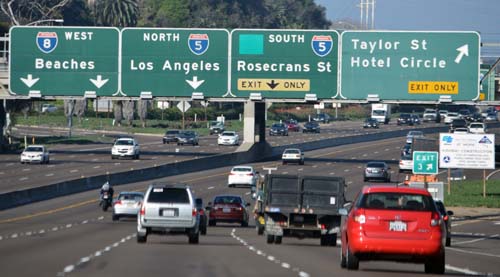

Pingback: California Highway Headlines for June 2015 « Observations Along the Road